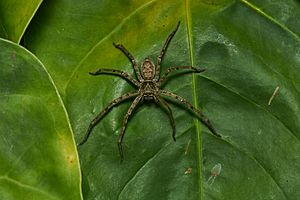Heteropoda venatoria facts for kids
Quick facts for kids Heteropoda venatoria |
|
|---|---|
 |
|
| Male | |
| Scientific classification | |
| Synonyms | |
|
Heteropoda venatoria is a type of spider often called the giant crab spider or cane spider. It belongs to the huntsman spider family, known for their speed. These spiders originally come from warm, tropical parts of the world. You can also find them in some subtropical areas where they were brought by people.
Contents
About the Giant Crab Spider
This spider has a flat, brown body. It is about 2 to 2.5 centimeters (0.8 to 1 inch) long. When you include its legs, it can be 7 to 10 centimeters (3 to 4 inches) wide.
Male and Female Differences
Female spiders might be a bit bigger than males, especially their main body part (abdomen). However, male spiders usually have longer legs. They also have larger tips on their pedipalps, which are like small feelers near their mouth.
Spider's Appearance
The area right in front of the spider's eyes, called the clypeus, is usually cream or yellowish. Behind its eyes, the top part of its body (carapace) has a wide band. This band is often tan in females and cream in males. The spider's body does not have much hair. But its legs have special hairs called setae that can stand up. Each of these hairs has a small black dot.
Life Cycle and Behavior
Giant crab spiders have interesting ways of living and reproducing.
Egg Sacs and Spiderlings
A female spider makes an egg sac that is about 2.5 centimeters (1 inch) wide. She carries this sac under her body using her pedipalps. The size of these egg sacs can vary. They usually hold more than 100 eggs, and some larger ones can have over 400 eggs. The tiny spiderlings inside the sac shed their skin (first molt) before they even come out.
Spider Lifespan
In one study, male spiders lived for about 465 days on average. Female spiders lived a bit longer, around 580 days.
Male Courtship Sounds
When a male spider wants to attract a female, it makes a special sound. It vibrates its abdomen while keeping its feet still. This sound is very quiet, but humans can sometimes hear it as a faint "buzz" or "hum."
Spider Bites
These spiders are not considered dangerous to humans. However, if they bite, they can inject enough venom to cause a painful sting.
What Giant Crab Spiders Eat
Giant crab spiders are good hunters. They help control pests in many areas.
Hunting Style
These spiders mostly eat insects. This includes different kinds of butterflies and moths, like the Elephant hawk moth. They do not spin webs to catch their food. Instead, they actively hunt and capture their prey directly. After catching an insect, the spider injects it with venom.
Helpful House Guests
In some warm, tropical places, people like having these spiders around their homes. This is because the spiders are very good at eating pest insects. They often live inside houses, barns, and sheds. They prefer these indoor places, especially where it gets cold outside. They cannot live outdoors in cold climates because they are sensitive to the cold.
Other Prey
Besides insects, these spiders have also been seen hunting and eating scorpions and even small bats.
Images for kids
See also
 In Spanish: Heteropoda venatoria para niños
In Spanish: Heteropoda venatoria para niños






